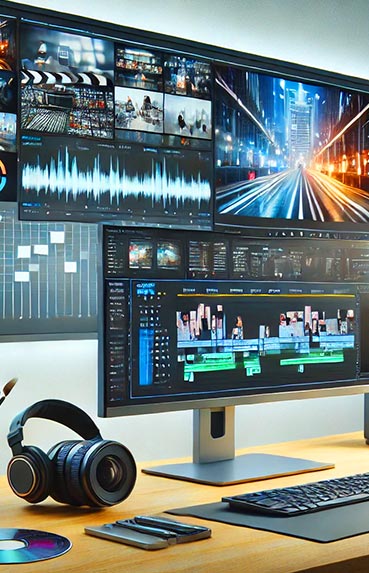In a world where online shopping has become an integral part of our daily lives, online store design has rapidly evolved to meet the increasingly demanding expectations of consumers. Companies are continuously seeking ways to optimize user experience (UX) to boost conversions and foster customer loyalty. As we move toward an increasingly digital future, it's crucial to stay updated with emerging trends in online store design. These trends not only enhance the digital storefront but also play a crucial role in how customers perceive and interact with a website. In this article, we'll explore some of the most significant trends in online store design that are transforming user experience.
User-Centered Design
Content Personalization
Personalization is one of the most impactful trends in online store design. A study by Epsilon found that 80% of consumers are more likely to make a purchase when brands offer personalized experiences. Personalization goes beyond simply addressing the customer by their name; it involves tailoring content and product recommendations based on browsing behavior, past purchases, and user preferences.
To implement effective personalization, online stores can:
- Use machine learning algorithms to analyze customer data and offer product recommendations.
- Create personalized email campaigns based on purchase history.
- Adapt website content to reflect user interests, such as displaying products similar to those previously viewed or purchased.
Intuitive Navigation
Simple and intuitive navigation is crucial for enhancing user experience. Consumers want to quickly find what they're looking for without having to navigate through multiple pages or complex menus. A clear and concise design not only reduces bounce rates but also increases conversion chances.
Strategies to improve navigation include:
- Implementing simple dropdown menus and clear categories.
- Including a prominent search bar with autocomplete capabilities.
- Using breadcrumbs to help users track their path within the site.
Attractive Visual Design
Minimalism and White Space
Minimalism continues to be a powerful trend in online store design. By eliminating visual clutter, products are allowed to shine, and site readability is enhanced. Strategic use of white space creates a cleaner, more focused design, making navigation easier and improving user experience.
Benefits of minimalism:
- Enhances focus on important products and calls to action.
- Increases site loading speed by reducing unnecessary elements.
- Provides a relaxing visual experience that retains users for longer.
Typography and Colors
The choice of typography and color palette can significantly impact how users perceive an online store. Clear, readable typography combined with a cohesive and attractive color palette can enhance site aesthetics and facilitate navigation.
Tips for choosing typography and colors:
- Opt for modern, easy-to-read fonts that reflect the brand identity.
- Use contrasting colors to highlight call-to-action buttons.
- Maintain color palette consistency throughout the site to strengthen branding.
Innovative Technology and Features
Integration of Augmented Reality (AR)
Augmented reality is revolutionizing the way consumers interact with online stores. It allows users to visualize products in a real-world setting before making a purchase, reducing uncertainty and increasing consumer confidence.
Examples of AR use in online stores:
- Virtually trying on clothes and accessories to see how they would look in real life.
- Visualizing furniture in a user's room to assess size and design.
- Using AR apps to provide interactive assembly instructions.
Chatbots and Virtual Assistants
Chatbots and virtual assistants are significantly enhancing customer service in online stores. These AI-powered tools can answer frequently asked questions, assist with order tracking, and provide personalized product recommendations.
Advantages of implementing chatbots:
- Offer 24/7 assistance without the need for human intervention.
- Can handle multiple queries simultaneously, improving efficiency.
- Collect valuable data on customer behavior for future improvements.
The use of advanced technologies like artificial intelligence and augmented reality not only enhances site functionality but also elevates user experience to a whole new level.
Mobile Optimization
Responsive Design
With the rise in mobile device usage, having a responsive design is essential for any online store. According to Statista, in 2021, 54.8% of global website traffic came from mobile devices. This underscores the importance of a design that adapts to different screen sizes without sacrificing quality or functionality.
Keys to effective responsive design:
- Ensure that images and site elements automatically adjust to different resolutions.
- Simplify navigation for touch screens.
- Optimize loading times for slower mobile connections.
User Experience in Mobile Apps
Developing mobile apps can offer a more personalized and seamless user experience than a traditional mobile website. Apps allow faster and easier access to store features and leverage device capabilities like push notifications and camera access.
Benefits of a mobile app:
- Improves customer loyalty by providing a more integrated experience.
- Facilitates access to exclusive offers and loyalty programs.
- Offers an optimized user interface for mobile devices.
User Security and Trust
SSL Certificates and Data Protection
Security is a top concern for consumers when shopping online. Ensuring that an online store is secure is crucial for gaining customer trust. Using SSL certificates to protect personal and payment information is a standard practice that should not be overlooked.
Measures to enhance site security:
- Implement two-factor authentication for logins.
- Display security seals and certificates on the payment page.
- Ensure privacy policies are clear and accessible.
Customer Reviews and Feedback
Customer reviews provide an additional layer of trust and can influence other users' purchasing decisions. Including a well-visible review section on product pages allows customers to share their experiences and helps others make informed decisions.
How to effectively manage customer reviews:
- Encourage satisfied customers to leave feedback through incentives.
- Respond quickly to negative reviews to demonstrate a commitment to customer satisfaction.
- Use constructive feedback to continuously improve products and services.
Interactive and Social Content
Product Videos
Product videos are gaining popularity as an effective tool to demonstrate a product's features and benefits. According to a Wyzowl report, 84% of people say they feel more convinced to buy a product after watching a video.
Advantages of using product videos:
- Provide a detailed visual demonstration that static images cannot offer.
- Increase time spent on the site, which can improve SEO.
- Facilitate the understanding of complex or innovative products.
Social Media Integration
Social media is a powerful tool for driving traffic and increasing an online store's visibility. Integrating social platforms allows users to easily share products and can boost word-of-mouth marketing.
Ways to integrate social media:
- Include social sharing buttons on product pages.
- Use platforms like Instagram and Pinterest to showcase products in a lifestyle context.
- Implement social media comments directly on the site to encourage interaction.
These trends in online store design are redefining how businesses interact with their customers in the digital realm. Adopting these practices not only enhances user experience but also positions brands for success in an ever-evolving market. As we continue to advance in the digital landscape, following these trends will be crucial for any business seeking to thrive in the world of e-commerce.

















